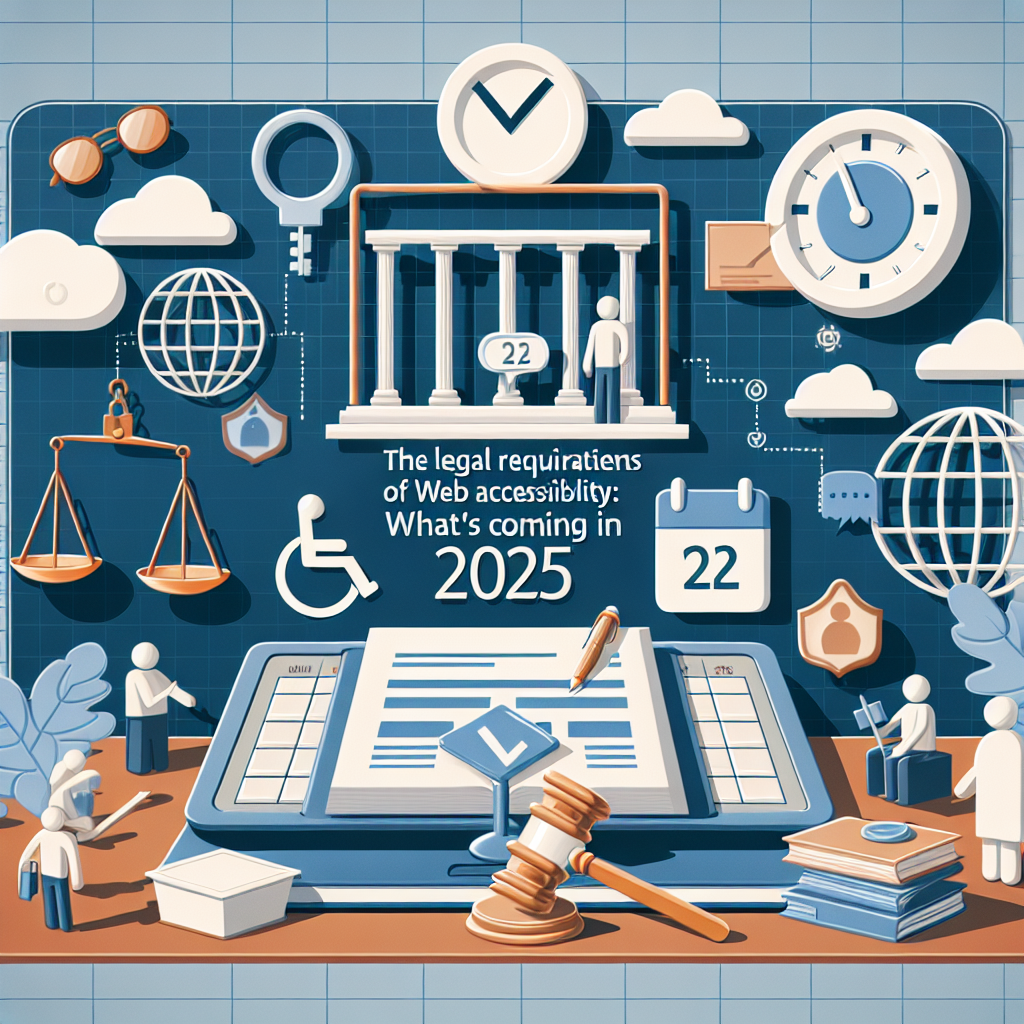
The legal requirements for web accessibility: What to expect in 2025
The legal requirements for web accessibility: What to expect in 2025
Introduction
The digital world is developing rapidly, and with it the requirements for accessibility on the web are increasing. By 2025 at the latest, the Website accessibility mandatory . This development is not only a step towards inclusion on the Internet, but also an important measure to make use easier for all of us. But what does this mean in concrete terms for companies and web developers?
Let's start with a basic question: Why is web accessibility so important? According to the World Health Organization (WHO), over 1 billion people worldwide live with some form of disability. That's about 15% of the world's population! The EU Accessibility Directive aims to make digital content accessible to this large population. In Germany, this is supported by the Disability Equality Act.
Digital inclusion is not a luxury, it is a necessity.¢Ââ
However, accessibility requires more than just compliance with regulatory requirements. We are talking about a holistic approach to designing websites in such a way that they can be optimally experienced by all users. This includes aspects such as screen reader compatibility, accessible navigation and responsive designs that adapt to different device sizes and requirements.
In this blog series, we take a closer look at the challenges and opportunities of digital accessibility in Germany by 2025. From WCAG standards to innovative accessibility tools for developers, there is a lot to discover and implement.
- Ease of use for all: A website should be intuitive to use, not only for people without restrictions.
- Legal requirements: What measures must be taken at all costs?
- Vision: What will the barrier-free Internet of the future look like?
Let's go on this exciting journey together and find out how we can make our digital spaces more inclusive!
Why is web accessibility important?
The question could just as well be: Why are ramps in front of buildings important? The answer is simple ¢Â to
to enable all people to have equal access. Digital accessibility is not just a
legal imperative, but also an essential factor for social justice and inclusion in the
Internet.
1. Create a universal user experience
Imagine a website being like a bookstore with no door handles, frustrating for many users.
Digital accessibility ensures that no one has to stop at the virtual doors. With a
accessible web design you can achieve:
- User-friendliness for all ¢¢âââ also for people with disabilities.
- Better accessibility and thus potentially more visitors.
- Positive impact on the image of your company or brand.
2. Meet legal requirements
According to the EU Accessibility Directive, all public bodies in Europe must make their digital services available by 2025.
Offers according to the WCAG Standards Germany adapt.
Private companies are also increasingly being held accountable. Compliance with these requirements
not only from legal consequences, but also opens new doors to a larger market segment.
Freedom of Command improves the web for both people with and without disabilities.W3C WAI (World Wide Web Consortium)
3. An investment in the future
With demographic change, the demand for barrier-free digital solutions will continue to increase. One
Early investment in digital accessibility ensures your long-term success and shows that your
company takes responsibility.
4. Overcoming technological challenges
Last but not least, the implementation of accessibility promotes innovation in the field of accessibility tools for developers.
For example, screen reader compatibility and responsive designs are crucial to design barrier-free navigation.
Let's tackle the challenges of accessibility in web design in 2025 together and make the internet an inclusive space!
Legal requirements for web accessibility by 2025
In today's digital world, Web accessibility is becoming increasingly important, not only as an ethical obligation, but also through legal requirements. By 2025, numerous new regulations are expected in Germany to ensure that digital content is accessible to everyone. These changes are based on the European EU Directive 2016/2102 , which mandates accessibility for websites and mobile applications of public bodies.
The new legal requirements aim to improve the accessibility of digital content and create an inclusive online experience. Here are some of the key areas that companies should focus on:
- WCAG Standards: The Web Content Accessibility Guidelines (WCAG) provide an international standard for ensuring website accessibility. Companies should follow these guidelines to ensure legal compliance.
- Ease of use for all: Websites must be designed in such a way that they can also be used by people with disabilities without any problems. This means, among other things, that texts must be easier to read and navigations must be intuitive and compatible with screen readers.
- Accessible multimedia content: Videos and audio content should include subtitles or transcripts to allow for full inclusion.
According to a study by W3C , around 15% of the world's population has some form of disability, which highlights the importance of accessible internet. These measures not only contribute to meeting legal requirements, but also to improving the overall user experience, a win-win situation for all parties involved!
"Accessibility should not be an afterthought; it should be a basic requirement." â Unknown
If you need support in implementing these requirements or simply want to learn more about accessible web design, our Barrier-free service practical solutions.
WCAG Standards and Their Meaning
In today's digital world, the Web accessibility no longer an optional feature, but a necessity. The Web Content Accessibility Guidelines, better known as WCAG , are the gold standard for creating an accessible Internet. These guidelines provide clear instructions on how to design web pages so that they are accessible to all groups of users, regardless of their physical limitations or technical capabilities.
WCAG is based on four principles: perceptible, operable, understandable and robust. These principles serve as a guide for developers and designers to optimize the accessibility of their web pages. Let's illustrate this with a simple example: A website with high-contrast colors helps people with visual impairments to recognize content better. What would the Internet be without a bit of color? Pretty boring, you could say!
The three levels of conformity
- Level A: The minimum requirements for a basic accessibility. Websites should at least meet these criteria.
- Level AA: This level ensures that significantly more people have access to the website. This is also the recommended level in many legal regulations worldwide.
- Level AAA: The highest level of accessibility. Few web pages meet all the requirements of this level given their strictness.
According to a study by the World Wide Web Consortium (W3C), the body behind the WCAG standards, it is expected that by 2025 at least 50% of all public websites in Germany will have to reach Level AA. This is a step towards an inclusive digital future.
"Digital accessibility is not just a technical issue, it's a matter of social responsibility." – W3C
Not convinced yet? Remember: an accessible website not only increases the reach of your content, but also improves the overall user experience and can even boost your search engine ranking! And if you're wondering how to design your website according to WCAG standards, take a look at our comprehensive Barrier-free service . Let's create an Internet together that excludes no one!
Challenges and solutions in the implementation of accessibility
The implementation of the Web accessibility is a complex process that brings with it a variety of challenges. But don't worry, with the right strategies, these hurdles can be overcome. Let's look at the main problems and their possible solutions.
1. Complexity of WCAG Standards
The WCAG standards (Web Content Accessibility Guidelines) form the backbone for accessible web design. However, these guidelines are extensive and can seem daunting even for experienced developers.
- Challenge: Full compliance with all standards can be time-consuming.
- Solution: Start with the essential aspects such as text alternatives for images and a clear structuring of content.
- Tip: Use accessibility tools such as WAVE or Axe to efficiently analyze your website and identify vulnerabilities.
2. Screen reader compatibility
Users with visual impairments are dependent on screen readers. Therefore, the website must be designed in such a way that it can be easily read by these tools.
- Challenge: The page is not logically structured or contains illegible elements for screen readers.
- Solution: Implement semantic HTML and Accessible Rich Internet Applications (ARIA) roles to streamline navigation for screen readers.
3. Ease of use for everyone
User-friendliness goes hand in hand with accessibility. But what does that mean in concrete terms? An accessible website must be intuitive to use – whether via mouse, keyboard or touchscreen.
- Challenge: Unclear navigation can frustrate and deter users.
- Solution: Rely on a clear responsive design and unambiguous menus that allow for easy orientation – especially important for people with cognitive impairments.
"It is not only important to ensure digital access; it is a fundamental step towards true inclusion." â Unknown
Although there are technical and organizational challenges in the implementation of accessibility, those who master them open up their digital presence to a wider audience. To learn more about innovative solutions, take a look at our article on strategic action in design: Strategic Plan – It's Called Doing Things .
Ready to future-proof your website? Then let's work together to achieve the 2025 digital accessibility targets!
Best Practices for Accessible Web Design
Creating an inclusive digital experience starts with an accessible web design. Here are some best practices to ensure the accessibility of your website:
1. Structured and logical navigation
Well-organized website navigation is crucial so that all users, including people with disabilities, can easily navigate through your content. Use clear menus and make sure each page has meaningful titles.
2. Screen reader compatibility
Make sure that your website can be read by screen readers. This includes using alt tags for images and avoiding tables to structure your content.
Proper implementation of alt text can greatly improve usability for the visually impaired. â – [Web Accessibility Initiative](https://www.w3.org/WAI/tutorials/images/decision-tree/)
3. Pay attention to colour contrast
Good color contrast is crucial for the readability of the content. It is recommended to use a contrast ratio of at least 4.5:1 to ensure that text is clearly visible on a background.
- Use tools like the WCAG Contrast Checker to help.
- Avoid using color as the only differentiator.
4. Use of responsive design
A responsive design ensures that your website remains accessible on all devices – just as important as the last coffee before the end of the day! Make sure your layout dynamically adapts to different screen sizes.
5. Focus management through keyboard navigation
Make sure that all interactive elements of your website are also accessible via the keyboard. This can be achieved by setting clear focus indicators and avoiding "keyboard traps".
Learn more about our digital accessibility services to best implement these best practices.
Future Outlook: Digital Inclusion in Germany by 2025
Digital inclusion in Germany is facing an exciting change. By 2025, we are challenged to achieve a digital accessibility that is truly accessible to all. One small step for us, one big step for humanity or at least for the disability-friendly web community! But seriously, the legal requirements for accessibility on the web are no longer just a bonus, but mandatory.
Here are some of the key aspects that will be in focus through 2025:
- Web Content Accessibility Guidelines (WCAG) 2.1: These standards are increasingly becoming established as an international benchmark and are also regarded as the basis for barrier-free websites in Germany.
- Ease of use for all: Websites should be designed in such a way that people with various disabilities can navigate easily. These include screen reader compatibility and barrier-free navigation.
- Compliance with the EU Accessibility Directive: These guidelines already oblige public bodies to implement them. It is high time for companies to follow suit.
According to a study by the European Commission, digital accessibility has huge potential to promote social inclusion while bringing economic benefits. It's a win-win situation: accessibility not only drives the user experience, but also market success.
"Digital inclusion is no longer a luxury, but a necessity." – Unknown Internet philosopher
The challenge is to develop web design in such a way that it meets the various needs. For example, a website could be created by using Responsive Design techniques to ensure content is accessible on all devices, from smartphones to large desktop monitors.
Not convinced yet? Remember, if we can learn, to implement strategic plans , we can certainly also meet the requirements for digital accessibility!
Conclusion: Understanding the Urgency of Digital Transformation
In today's digital era, web accessibility has long since ceased to be an option, but a necessity. With the year 2025 approaching, we are at a turning point where the "Accessibility Website Obligation 2025" will become a reality. An obligation that is not only enshrined in law, but also appears to make ethical and economic sense.
Why is this so urgent? A look at the EU Accessibility Directive shows that from 2025 onwards, all public websites and apps in Europe will have to comply with the requirements of accessibility standards. In concrete terms, this means that digital content must be accessible to all users, regardless of their physical abilities.
Companies that are already using the Implementation of accessibility can not only avoid legal problems, but also increase their reach. After all, there are over a billion people with disabilities worldwide. So the question is no longer if, but when you will make your websites accessible to everyone.
The advantages at a glance:
- Extended target groups: More people can take advantage of your offers.
- Better user experience: An accessible website offers a better user experience for all visitors.
- SERPs optimization: Search engines prefer content that is structured according to accessibility standards.
An example from Germany: The city of Munich recently completely redesigned its city website and relied on barrier-free web design. The result? A significant increase in the number of visitors and positive feedback from users with different abilities.
"Web accessibility is not a luxury. It is a fundamental human right." – Unknown
Whether large companies or small start-ups, everyone should take the change towards an inclusive Internet seriously. And if you think this is a mammoth task, remember: Rome wasn't built in a day either! Getting to meet the 2025 accessibility targets in Germany step by step could ultimately help grow your business while ensuring that no one is left out.

